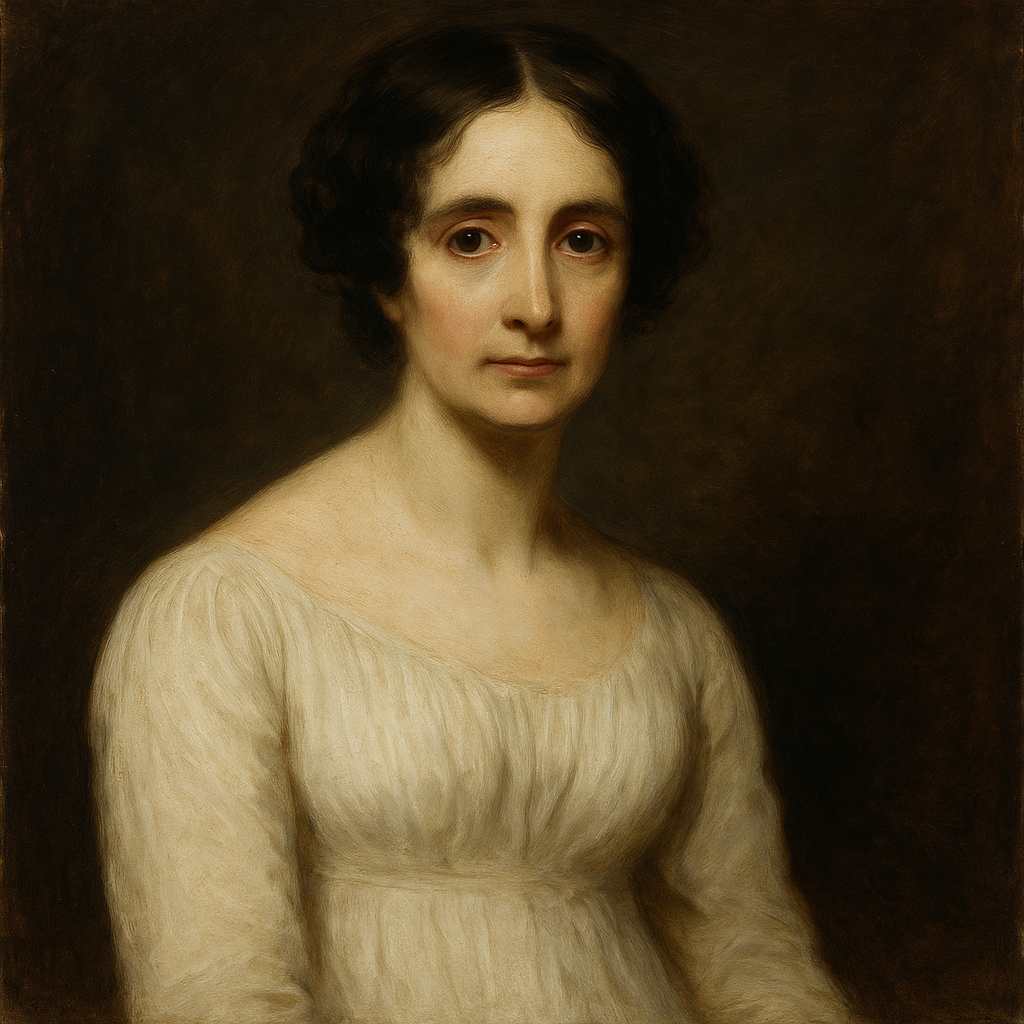Oh, come to me in dreams, my love!
Mary Wollstonecraft Shelley
1797 to 1851

Want to track your favorites? Reopen or create a unique username. No personal details are required!
Oh, come to me in dreams, my love!
I will not ask a dearer bliss;
Come with the starry beams, my love,
And press mine eyelids with thy kiss.
'Twas thus, as ancient fables tell,
Love visited a Grecian maid,
Till she disturbed the sacred spell,
And woke to find her hopes betrayed.
But gentle sleep shall veil my sight,
And Psyche's lamp shall darkling be,
When, in the visions of the night,
Thou dost renew thy vows to me.
Then come to me in dreams, my love,
I will not ask a dearer bliss;
Come with the starry beams, my love,
And press mine eyelids with thy kiss
Mary Wollstonecraft Shelley's Oh, come to me in dreams, my love!
Mary Wollstonecraft Shelley, best known for her groundbreaking novel Frankenstein, was also a gifted poet whose works often explored themes of love, loss, and the interplay between reality and imagination. Her poem "Oh, come to me in dreams, my love!" is a poignant expression of longing and the transcendent power of dreams. Written in the early 19th century, the poem reflects the Romantic era's fascination with emotion, the supernatural, and the idealization of love. Through its lyrical structure, rich imagery, and classical allusions, Shelley crafts a work that is both deeply personal and universally resonant.
Historical and Cultural Context
To fully appreciate Shelley’s poem, it is essential to situate it within the historical and cultural milieu of the Romantic period. The early 19th century was a time of profound social and intellectual upheaval, marked by the aftermath of the French Revolution, the rise of industrialization, and a growing disillusionment with Enlightenment rationalism. Romantic writers, including Shelley, sought to counterbalance the era’s mechanistic worldview by emphasizing emotion, imagination, and the sublime. This cultural shift is evident in Shelley’s poem, which prioritizes the emotional and the ethereal over the concrete and the rational.
Shelley’s personal life also informs the poem’s themes. Her marriage to Percy Bysshe Shelley, a leading Romantic poet, was both passionate and tumultuous. The couple’s shared interest in the power of dreams and the supernatural is reflected in this poem, which blurs the boundaries between waking life and the dream world. Additionally, Shelley’s own experiences of loss—most notably the deaths of her mother, Mary Wollstonecraft, and several of her children—lend a poignant undertone to her exploration of love and longing. The poem can thus be read as both a celebration of romantic idealization and a meditation on the fragility of human connection.
Themes and Emotional Impact
At its core, "Oh, come to me in dreams, my love!" is a meditation on the transformative power of dreams and the yearning for an idealized love. The speaker’s plea for their beloved to visit them in dreams underscores the tension between reality and imagination. Dreams, in this context, are not mere escapism but a realm where the boundaries of time, space, and mortality can be transcended. The poem’s emotional impact lies in its ability to evoke a sense of both hope and melancholy. The speaker’s desire for a “dearer bliss” suggests a recognition that such perfect love may be unattainable in waking life, yet the act of dreaming offers a temporary reprieve from this reality.
The theme of betrayal, introduced in the second stanza, adds a layer of complexity to the poem. The reference to the “ancient fables” of a Grecian maid whose hopes were betrayed serves as a cautionary tale, reminding the reader of the fragility of love and the potential for disillusionment. However, the speaker’s resolve to embrace “gentle sleep” and the “visions of the night” suggests a willingness to risk such betrayal for the sake of experiencing love, even if only in dreams. This interplay between hope and despair is characteristic of Romantic literature, which often grappled with the tension between idealism and reality.
Literary Devices and Imagery
Shelley’s use of literary devices is masterful, enhancing the poem’s emotional depth and thematic complexity. The poem’s imagery is particularly striking, drawing on celestial and mythological motifs to create a sense of otherworldly beauty. The “starry beams” that accompany the beloved in the speaker’s dreams evoke a sense of cosmic harmony, suggesting that their love is not merely personal but part of a larger, universal order. This celestial imagery is reinforced by the reference to Psyche’s lamp, a nod to the ancient myth of Cupid and Psyche. In the myth, Psyche’s attempt to uncover Cupid’s identity by shining a lamp on him leads to their separation, symbolizing the dangers of curiosity and the fragility of trust. By invoking this myth, Shelley underscores the tension between desire and the potential for loss.
The poem’s structure and rhythm also contribute to its emotional resonance. The repetition of the opening lines in the final stanza creates a circular structure, emphasizing the speaker’s unwavering longing and the cyclical nature of dreams. The use of enjambment, particularly in the second stanza, mirrors the fluidity of the dream state, blurring the boundaries between lines and ideas. The poem’s meter, while regular, is softened by its lyrical quality, creating a sense of intimacy and immediacy.
Symbolism and Allusion
Shelley’s use of symbolism and allusion enriches the poem’s thematic depth. The figure of Psyche, as mentioned earlier, serves as a powerful symbol of the soul and its yearning for union with the divine. By aligning the speaker’s experience with Psyche’s, Shelley elevates their longing to a metaphysical level, suggesting that the desire for love is not merely emotional but spiritual. The “sacred spell” mentioned in the second stanza further reinforces this idea, implying that love, like a spell, has the power to enchant and transform.
The poem’s allusion to “ancient fables” also situates it within a broader cultural and literary tradition. By referencing classical mythology, Shelley aligns her work with the Romantic fascination with the past and the idea of timeless truths. This intertextuality invites the reader to consider the poem not as an isolated expression of emotion but as part of an ongoing dialogue about love, loss, and the human condition.
Emotional Resonance and Universality
One of the poem’s greatest strengths is its ability to resonate with readers on an emotional level. While rooted in the specific context of Shelley’s life and the Romantic era, its themes of love, longing, and the power of dreams are universal. The speaker’s plea for their beloved to visit them in dreams is a sentiment that transcends time and culture, speaking to the fundamental human desire for connection and transcendence. The poem’s emotional impact is further heightened by its delicate balance of hope and melancholy, which captures the bittersweet nature of love.
Conclusion
Mary Wollstonecraft Shelley’s "Oh, come to me in dreams, my love!" is a masterful exploration of love, longing, and the transformative power of dreams. Through its rich imagery, classical allusions, and lyrical structure, the poem captures the essence of Romantic idealism while acknowledging the fragility of human connection. Its emotional resonance and thematic depth make it a timeless work that continues to speak to readers across generations. Shelley’s ability to evoke both the ethereal and the deeply personal is a testament to her skill as a poet and her sensitivity to the complexities of the human experience. In this poem, she reminds us of the enduring power of love and the solace that can be found in the realm of dreams.
This analysis, while thorough, only scratches the surface of the poem’s richness. Shelley’s work invites repeated readings and ongoing reflection, offering new insights with each encounter. It is a testament to the enduring power of poetry to connect us with our deepest emotions and to illuminate the mysteries of the human heart.
This text was generated by AI and is for reference only. Learn more
Want to join the discussion? Reopen or create a unique username to comment. No personal details required!



Comments
No comments yet. Be the first to comment!